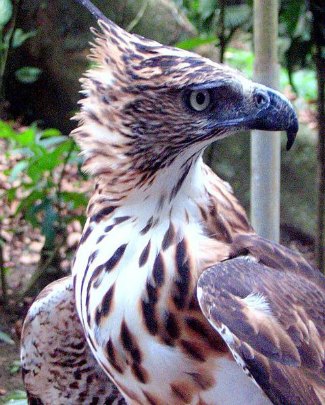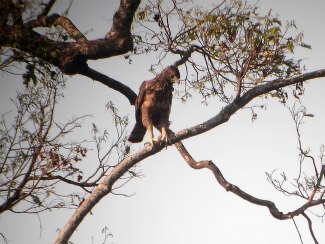Philippine Hawk Eagle - Nisaetus philippensis
By Chris Angelo Perez, CC-BY-2.0, via Wikimedia Commons
Family: Accipitridae
Genus: Nisaetus
Species: N. philippensis
Philippine Hawk Eagles are medium-sized raptors that are endemic to the island of Luzon in the Philippines. They live in primary and secondary forest, but their habitat is disappearing the population is declining. They form a clade with N. cirrhatus (Crested Hawk Eagle), N. pinskeri (Pinsker’s Hawk Eagle), and N. lanceolatus (Sulawesi Hawk Eagle).
Physical Description:
Philippine Hawk Eagles are dark brown from above and have a long crest that can be up to 8 cm long and consists of 4-5 black feathers. The head is brown and streaked with black and the throat is white, bordered by black stripes. The underparts are rufous with black streaks and the legs are finely barred black and white. Eyes and legs are bright yellow, and the cere and hooked beak are dark gray. The tail is long and square-shaped and has 4-5 black bars and a black subterminal band. There are 8-9 black bars along the primary feathers and 7-8 on the secondaries; males have visible light panels, but the females' are duller.
Juveniles have a white head and underparts and the back and wings are brown. Their tail is gray-brown with 6-8 black bars and a white tip. The eyes are gray-brown to yellow. They reach full adult plumage after four years.
They are highly vocal birds and their call is a high-pitched series of whistles. Listen to a Philippine Hawk Eagle.
Size:
Length: 50-63 cm
Wingspan: 105-125 cm
Weight: 1.1-1.2 kg
Habitat and Distribution:
They live in primary dipterocarp forest (forest with resinous trees) and secondary growth forest that has been selectively logged 20-30 years previous, while avoiding mossy forest. They are found along lowlands and mountains from 0-1,000 meters above sea level.
Philippine Eagles are endemic to Luzon Island in the Philippines. Adults are sedentary, though juveniles disperse from their breeding areas. There are an estimated 400-440 individuals.
Diet and Hunting:
No information, though they probably specialize in birds.
By markaharper1, CC-BY-SA-2.0, via Flickr
Reproduction:
No information.
Conservation:
BirdLife International does not recognize the split between Nisaetus philippensis and Nisaetus pinskeri (see below Taxonomy), but as a whole the two species are considered Vulnerable. Taken separately, their individual statuses are probably closer to Endangered. The population is assumed to be declining due to habitat loss in the form of logging and agriculture.
Conservation measures proposed include further research into their ecology and the effects of habitat fragmentation and promoting legislation to control hunting and trade.
Taxonomy:
Based on molecular data and morphological differences, Nisaetus philippensis has been separated from Nisaetus pinskeri (Pinsker's Hawk Eagle), which was formerly considered a subspecies of N. philippensis (by some authorities). N. pinskeri has been raised to full species status. N. philippensis forms a clade with N. cirrhatus (Crested Hawk Eagle), N. pinskeri, and N. lanceolatus (Sulawesi Hawk Eagle).
Genus Nisaetus used to be considered part of genus Spizaetus. However, molecular studies of one nuclear intron and two mitochondrial genes have shown that New World hawk eagles are part of a separate lineage than that of Old World species (Spizaetus), and have consequently been moved into the new genus Nisaetus.
Other Names:
Orel filipínský (Czech), Filippinsk Høgeørn (Danish), Filippijnse Kuifarend (Dutch), Filippiinienjalokotka (Finnish), Aigle des Philippines (French), Philippinenadler (German), Aquilastore delle Filippine (Italian), Filippinerskogørn (Norwegian), Aguila-azor Filipina (Spanish), Filippinsk örn (Swedish).
Video of a Philippine Hawk Eagle:
References:
http://avibase.bsc-eoc.org/species.jsp?avibaseid=7E5E739E477B3936
BirdLife International (2012) Species factsheet: Nisaetus philippensis. Downloaded from http://www.birdlife.org on
08/02/2012.
Global Raptor Information Network. 2012. Species account: Northern Philippine Hawk-eagle Nisaetus philippensis. Downloaded from
http://www.globalraptors.org on 8 Feb. 2012
BirdLife International 2008. Nisaetus philippensis. In: IUCN 2011. IUCN Red List of Threatened Species. Version 2011.2.
www.iucnredlist.org. Downloaded on 08 February 2012.
http://www.orientalbirdclub.org/publications/forktail/14pdfs/Gamauf-Philippines.pdf
http://www.planetofbirds.com/accipitriformes-accipitridae-philippine-hawk-eagle-nisaetus-philippensis
Ferguson-Lees, James, and Christie, David A. Raptors of the World. Houghton Mifflin Company, 2001.

